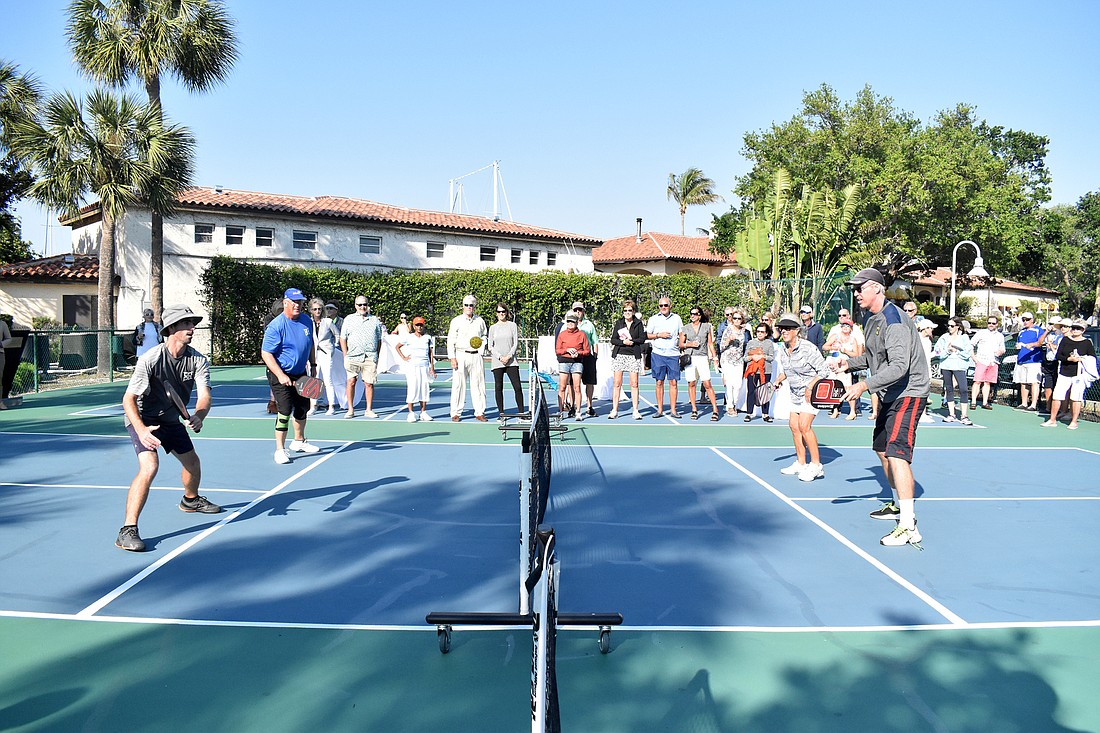- December 23, 2024
-
-
Loading

Loading

Four new pickleball courts at Longboat Key Club are beginning the transition from vision to reality but only after months of controversy, with more possible between now and final consideration.
The Key Club’s new plans for the courts were unanimously approved to move forward by the town’s Planning and Zoning Board Nov. 15 following relocation of the site and a sound study prompted by neighboring resident complaints.
The pickleball courts, proposed for 3000 Harbourside Drive, will be built south of the original plans, replacing existing parking. which moves them farther from Winding Oaks, neighbors from which banded together last spring to object to the plans, citing noise and nighttime lighting concerns.
“(The plan) is not meant to make anyone’s life miserable,” lawyer John Patterson said, representing the club. “The relocation of the site is responsive to both sound and light complaints.”
The sound study was conducted by Keane Acoustics as the club looked to compile had data regarding the sound levels of the sport, which has an anecdotal reputation as a noisy endeavor.
The study results showed that even without sound-deadening materials planned for the courts, noise from the courts would not exceed decibel levels already expected with surrounding ambient noise such as traffic.
“Even without the barrier, using (the town’s) sound ordinance as a guideline, the plan absolutely complies,” Patterson said.
Additional elements of the plan include:
Board members raised issues with the application’s plans for trees affected by construction. The town staff presentation indicated that the number of trees planned for removal would require the club to plant 116 trees. However, the club offered to pay into the town’s tree fund in lieu of planting.
Following public comment supporting preservation of the trees, town staff, in collaboration with the applicant added conditions of approval including increased placement of trees. A revised site plan will be required with recommendations from the sound study before it is brought before commissioners.
"This is just an example of them doing what we asked them to do," board member Gary Coffin said. "They went and got a sound test. They went and actually moved the courts on top of that. That's respectable. In an effort to try and please everybody, which is impossible no matter what, I think this is a great effort."
The new plans were not without disapproval, though. Residents, town staff and board commissioners alike were present at the meeting to hear public comments and board deliberation. The entire issue was debated for just under three-and-a-half hours.
All seats were taken in the Town Hall chambers. Commissioners Mike Haycock and Debra Williams along with Mayor Ken Schneier were among audience members.
Public comment was less centered on objections and concerns with the placement of the new courts as the previous plans.
Residents in neighboring communities and members of the club spoke in support of the new plans as the sport continues to grow in popularity on the barrier island.
Resident Kevin Mulkern’s statement to the board centered on the community he has found through the sport since moving to the barrier island about three years ago.
“We need this space,” he said. “We need these courts. It’s not just the courts, but the community that goes with it.”
Neighbors closest to the property raised their own concerns of diminishing property values and remained unconvinced that the sound would not be an issue.
Paul Anisman, whose property is among the closest to the proposed courts, urged consideration of further relocation after playing a sound bite of an experiment he did himself relating to the sound of pickleball.
“The problem is avoidable,” he said.
Phill and Fanny Younger, who have also live near the site, asked the applicant and the board to consider further alternatives for the location of the courts, speaking in favor of moving them closer to the Harbourside marina to allow the water to trap any noise associated.
“I’m glad our board can serve as a sounding board for community complaints,” board member Jay Plager said. “We have a broad responsibility to exercise judgment to whether a proposal like this is a good thing for the town and for the related community, whether it meets all the technical requirements is something different.”
The club’s original plan was to build the four courts adjacent to its Harbourside Tennis Gardens. Those plans were unanimously approved and set to move on to the Town Commission on June 6.
Following the initial public hearing in April, residents of the nearby Winding Oaks community raised objections about potential noise, and many complained they had not been notified of the meeting until after it had taken place.
The town began investigating mailings and learned the club’s representative in the project met the town’s 14-day requirement, but the notices did not arrive in many cases until after the initial public meeting took place.
At the Planning and Zoning board’s May 17 meeting, attorney Edward Willner of the Sarasota firm of Lobeck and Hanson made a request for the matter to be heard again on behalf of Winding Oaks residents.
The original site was planned adjacent to the Tennis Garden’s courts in an area where trees now stand between the golf course and the tennis facility. The courts were proposed to be no closer than 328 feet from the nearest Winding Oaks home, which is farther away than existing courts are from residential property alongside the Moorings.
At the hearing for the new plan, residents of the Winding Oak neighborhood spoke in favor of the new location and thanked the club for taking their concerns into account.
The rehearing was rescheduled multiple times in order for the club to complete plans and conduct the sound study before presenting final plans and reports to both the board and the public.